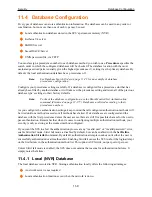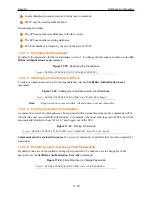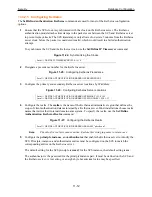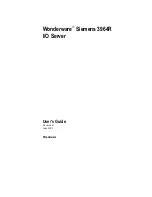
Security
Network Restrictions
11-22
Unique authentication applies only to ports that have authentication enabled. If user george connects to
port2 and then attempts a second connection to port9, the second login will be allowed because port9 does
not have authentication enabled. Similarly, if george attempts an authenticated login to port 2 after another
user has logged into port9 with username george, he will succeed (provided that he enters the correct
password) because he is the first user to log in as george on an authenticated port.
To enable unique authentication, enter the following command:
Figure 11-42:
Preventing Multiple Authenticated Logins By Single Users
11.6 Network Restrictions
11.6.1 Incoming Telnet/Rlogin Connections
Incoming Telnet and Rlogin connections can be permitted without restriction, password protected, or
prevented entirely. By default, incoming Telnet and Rlogin connections are permitted without entering the
login password; to change this configuration, use the
Set/Define Server Incoming
command:
Figure 11-43:
Preventing Incoming Telnet/Rlogin Logins
Note:
The complete syntax of the Set/Define Server Incoming command is discussed on
page 12-119.
In Figure 11-43, the first command prevents all incoming Telnet and Rlogin connections. The second
command permits the connections, but requires that the login password be entered before the connection is
permitted. The third command disables incoming Telnet and Rlogin (along with 200x and 300x ports). See
Set/Define Server Incoming
on page 12-119 for more information.
When Incoming None is specified, incoming SSH connections are also denied. The other parameters do not
affect incoming SSH connections.
11.6.2 Outgoing Rlogin Connections
The
Set/Define Server Rlogin
setting controls whether or not outgoing Rlogin connections are permitted.
By default, outgoing Rlogin is disabled; to change this setting, use the following command:
Figure 11-44:
Permitting Outgoing Rlogin Connections
11.6.3 Limiting Port Access
A port’s access may be set to one of the following: dynamic, local, remote, or none.
Dynamic
permits both
local and remote logins,
local
permits only local logins, and
remote
permits only remote logins.
None
prevents all incoming and outgoing connections; the port is unusable.
Local>> DEFINE AUTHENTICATION UNIQUE ENABLED
Local>> DEFINE SERVER INCOMING NONE
Local>> DEFINE SERVER INCOMING PASSWORD
Local>> DEFINE SERVER INCOMING SECURE
Local>> DEFINE SERVER RLOGIN ENABLED
Содержание SCS
Страница 14: ...xii ...
Страница 171: ...Modem Sharing Examples 10 6 ...
Страница 314: ...Command Reference Service Commands 12 110 ...
Страница 403: ...Show 802 11 Errors Rightmost Number B 5 00000002 Internal error 00000001 Internal error ...
Страница 424: ...Index 13 ...
















































